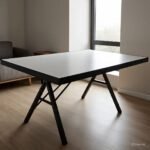Last Updated on March 8, 2025 by Aiman Emaan
Dining tables are the centerpieces of our homes, where memories are created and bonds are strengthened through shared meals. In recent years, global influences have shaped modern dining table designs, blending worldwide cultural aesthetics with functional sensibilities. Let’s explore some of these global impacts revolutionizing the world of dining tables.
As we navigate through the world of dining tables influenced by global aesthetics, we discover more than just furniture. We encounter cultural dialogues, historical echoes, and a celebration of diversity. Dining tables, once simple functional items, have evolved into cultural artifacts that transcend borders. They stand as testaments to the universal nature of design, weaving together threads from different corners of the world into the very fabric of our homes. In celebrating this richness, we not only furnish our dining spaces but also honor the interconnected tapestry of global design.
Table of Contents
Cultural and Historical Influences Bring Global Flair
The diversity of cultural and historical influences is reinterpreted in modern design trends, creating a global fusion. Contemporary designs reflect a modern perspective on traditional elements, marrying the richness of cultural heritage with the demands of contemporary living.
The amalgamation of influences from different parts of the world results in tables that showcase cross-cultural aesthetics and a universal appeal.
Some specific cultural styles include:
Mediterranean Inspirations:
- Climate and Cultural Integration: Mediterranean courtyards, exemplified by regions like Spain, Greece, and North Africa, influence table designs that seamlessly integrate indoor-outdoor living. Dining spaces with a round marble dining table are some of the influences of Mediterranean-style furniture.
- Modern Adaptations: Contemporary tables draw inspiration from these influences, featuring elements like glass tops and sectional designs that cater to alfresco dining.
- Cultural Depth: The influence of Mediterranean culture runs deep, contributing to the aesthetic and functional aspects of modern tables.
Asian and Middle Eastern Latticework
- Intricate Carved Details: Historical latticework techniques from Asian and Middle Eastern cultures find expression in modern table designs through intricately carved details.
- Ornate Influences: Latticed wood, with its ornate patterns, serves as a global accent, seamlessly blending historic influences into the clean lines of modern minimalist spaces.
- Cultural Heritage: These designs bring a sense of cultural heritage, adding a layer of storytelling to the contemporary furniture.
European Elegance:
- Elegantly Tapered Legs: European influences are evident in the design elements such as elegantly tapered table legs, conveying a sense of refinement and sophistication.
- Refined Carvings: Tables may feature refined carvings, reflecting the craftsmanship associated with European furniture traditions.
- Modern Interpretation: Modern tables reinterpret these European design elements through a contemporary lens, creating a fusion of old-world charm and new-age aesthetics.
The tables of today seamlessly weave together cultural and historical threads from the Mediterranean, Asia, the Middle East, and Europe. The result is a global tapestry of design that brings depth, meaning, and a touch of cultural richness to modern living spaces.
Innovative Materials and Textiles Fuse Traditional Crafts and Modern Aesthetics
Designers like Hella Jongerius are pioneering the use of innovative textiles in furniture design, incorporating materials like hand-knotted yarn and porcelain beads. This reflects a global trend towards blending traditional crafts with modern aesthetics for visually striking creations.
Global textile trends range from lustrous silks to ethnically inspired wools and natural fibers, adding cultural depth through variegated weaves and elaborate embroidery. Table runners and placemats integrate these diverse materials for a layered cultural narrative.
Technological advancements allow the innovative use of wood, laminates and ceramics in textured tabletops and artistically sculpted legs. Cross-cultural collaborations between designers across geographies lead to pathbreaking global fusions.
Sustainable Materials and Eco-Friendly Technology Showcase Global Commitment
The global design community is increasingly embracing sustainable materials and practices, showcasing a commitment to environmental responsibility. From restaurants to home dining spaces. Ecological styles are worldwide. Natural woods are sourced from responsibly managed forests. Laminates and metals use recycled content. Non-toxic finishes reduce VOC emissions.
Energy-efficient LED lighting and smart home automation technologies are integrated seamlessly into dining tables and lighting fixtures for an eco-friendly upgrade. Multi-functional designs optimize resources by allowing convenient table extensions.
Eco-friendly materials like bamboo, jute and natural fibers make a green statement in handcrafted placemats and table runners. Across the spectrum, global influences promote sustainability alongside style.
The global design community is not just shaping tables; it’s crafting a narrative of a conscientious and sustainable approach to living spaces, where each piece of furniture tells a story of environmental responsibility and global unity.
Function Meets Cultural Aesthetics for Locally Inspired, Globally Loved Pieces
Designers across the world draw inspiration from their surroundings, creating functional pieces that resonate locally yet attract global appeal. For instance, Gaetano Pesce’s modular UP5 armchair features bold textures inspired by the urban fabric of Milan, fusing cultural aesthetics with adaptable usability.
Vibrant colors and tactile materials inspired by tropical locales add energetic accents through tablecloths, placemats and ceramics. Customization options allow personalized selections that integrate cultural preferences with practical functionality.
Ergonomic designs informed by traditional floor seating make modern dining tables amenable to tailored dining styles. Fusing stylish cultural influences with ergonomic and functional design creates globally loved, culturally rooted dining tables.
Frequently Asked Questions (FAQs)
How do cultural influences shape modern dining table designs?
From architectural inspirations like Mediterranean courtyards to decorative detailing based on Asian latticework, cultural influences impart unique design aesthetics. They inject historical charm, handcrafted materials, and local textures into contemporary global designs.
What are some emerging trends in global furniture design?
Key trends include sustainable materials, technology integration for smart functionality, innovative textiles that blend traditional and modern, and highly customized designs with local accents.
Can sustainable practices and technology coexist in table design?
Yes, sustainable materials and manufacturing processes are being seamlessly combined with tech integration. Multi-functional extendable tables and eco-materials demonstrate this coexistence.
Final Takeaway
In essence, the dining tables of the future transcend their utilitarian origins, evolving into symbolic representations of cultural diversity, sustainability, and enduring design. This evolution is characterized by the fusion of global influences, tailored functionality to suit local needs, and a steadfast commitment to eco-friendly practices. Beyond mere objects, these dining tables become ambassadors, embodying our collective aspirations for a future where cultural richness and environmental responsibility coalesce seamlessly. As we gather around these tables, we partake in a shared experience that transcends boundaries, fostering a sense of harmony and interconnectedness in our homes and beyond.
















